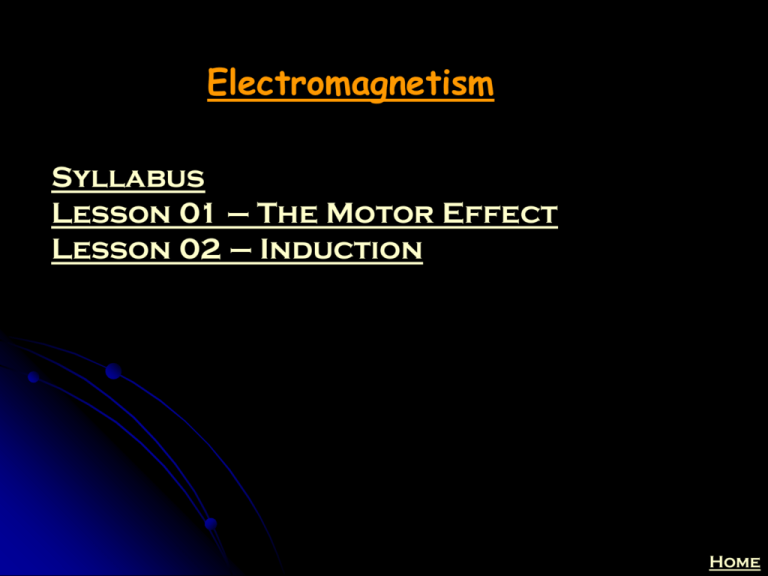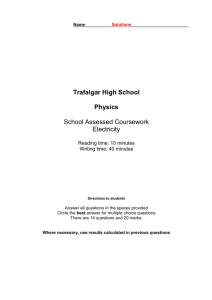Electromagnetism
advertisement

Electromagnetism •Syllabus •Lesson 01 – The Motor Effect •Lesson 02 – Induction Home Syllabus - Single Science IGCSE Magnetism 6.2 recall that magnets repel and attract other magnets, and attract magnetic substances 6.3 recall the properties of magnetically hard and soft materials 6.4 understand the term ‘magnetic field line’ 6.5 understand that magnetism is induced in some materials when they are placed in a magnetic field 6.6 sketch and recognise the magnetic field pattern for a permanent bar magnet and that between two bar magnets 6.7 know how to use two permanent magnets to produce a uniform magnetic field pattern Electromagnetism 6.8 recall that an electric current in a conductor produces a magnetic field round it 6.9 describe the construction of electromagnets 6.10 sketch and recognise magnetic field patterns for a straight wire, a flat circular coil and a solenoid when each is carrying a current 6.11 appreciate that there is a force on a charged particle when it moves in a magnetic field as long as its motion is not parallel to the field 6.12 recall that a force is exerted on a current-carrying wire in a magnetic field, and, how this effect is applied in simple d.c. electric motors and loudspeakers 6.13 predict the direction of the resulting force when a wire carries a current perpendicular to a magnetic field 6.14 recall that the force on a current-carrying conductor in a magnetic field increases with the strength of the field and with the current Electromagnetic induction 6.15 recall that a voltage is induced in a conductor when it moves through a magnetic field or when a magnetic field changes through a coil; also recall the factors which affect the size of the induced voltage 6.16 describe the generation of electricity by the rotation of a magnet within a coil of wire and of a coil of wire within a magnetic field; also describe the factors which affect the size of the induced voltage 6.17 recall the structure of a transformer, and understand that a transformer changes the size of an alternating voltage by having different numbers of turns on the input and output sides 6.18 explain the use of step-up and step-down transformers in the large-scale generation and transmission of electrical energy 6.19 recall and use the relationship between input (primary) and output (secondary) voltages and the turns ratio for a transformer secondary turns / primary turns = output (secondary) voltage / input (primary) voltage 6.20 recall and use the relationship input power = output power VP IP = VS IS for 100% efficiency Home Syllabus – Double IGCSE Magnetism and electromagnetism understand the term ‘magnetic field line’ (P2.19) recall that an electric current in a conductor produces a magnetic field round it (P2.20) recall that a force is exerted on a current-carrying wire in a magnetic field, and, how this effect is applied in simple d.c. electric motors and loudspeakers (P2.21) predict the direction of the resulting force when a wire carries a current perpendicular to a magnetic field (P2.22) recall that the force on a current-carrying conductor in a magnetic field increases with the strength of the field and with the current (P2.23). Electromagnetic induction recall that a voltage is induced in a conductor when it moves through a magnetic field or when a magnetic field changes through a coil; also recall the factors which affect the size of the induced voltage (P2.24) describe the generation of electricity by the rotation of a magnet within a coil of wire and of a coil of wire within a magnetic field; also describe the factors which affect the size of the induced voltage (P2.25). Home The Motor Effect 18/03/2016 Aim: • To use Flemming’s Left Hand Rule • To explain how a motor works • To construct a motor Home Fields Bar Magnets Single Science Only handout Home Opposite Poles Single Science Only Home Same Poles Single Science Only Home Fields due to Current Home Single Science Only Single Coil of Wire Solenoid Home Magnetic Field Lines There are magnetic field lines around every Magnet Electrical wire (with current flowing through it) Anything magnetic in the field will experience a force Movie Home Wire in a magnetic field Home The Catapult (Motor) Effect Home Motor Effect If a conductor carrying an electric current moves through magnetic field lines at right angles it will experience a force. A charged particle will experience the same effect Home Fleming's left hand rule Home Demo with Motor Effect Apparatus Home Increasing the Size of the Force Home The motor effect: true or false? Home Single Science Only Exam Question Home Single Science Only Exam Question Home Coil in a Magnetic Field Home How does an electric motor work? Home Demo Motor Home DC electric motor simulation Home How do we increase motor strength? Would the same strength motor be used in both of these? How can the strength of an electric motor be increased? increase the current flowing through the coil increase the strength of the magnet increase the number of turns on the coil Worksheet Home The Motor Effect recap Aim: • To use Flemming’s Left Hand Rule • To explain how a motor works • To construct a motor Home Induction 18/03/2016 Aim: •To observe and define induction •To explain how electricity is generated Home Exam Question Home Exam Question Home Inducing current in a wire Home What is electromagnetic induction? Current Carrying Wire + Magnetic field = Motion Motion + Magnetic field = Current in Wire Changing Magnetic field = Current in wire If they are at right angles to each other Home Inducing current in a coil Home Induction If a magnet is moved near a coil of wire a current is induced in the wire • Faster motion, bigger current • Stronger magnet, bigger current • More turns, bigger current • Change direction of motion, change direction of current Home Factors affecting induced current Home How can motion produce a current? Home What are Generators? A generator is a device that converts mechanical energy into electrical energy. It is the opposite of an electric motor. Power stations use generators to produce electricity on a large scale. Mechanical energy is provided by rotating turbines that can be powered by: high-pressure steam – in coal, oil, gas and nuclear power stations wind – in wind turbines falling water – in hydroelectric power stations Home How do AC generators work? Home AC generator simulation Home Induction: true or false? Home What is a transformer? The voltage of an alternating current can be changed using a device called a transformer. A transformer contains two coils that are wound around a soft iron core. iron core The alternating current in the primary (input) coil produces an alternating magnetic field. This alternating magnetic field induces an alternating current in the secondary (output) coil. primary coil secondary coil Home How does a transformer change voltage? The voltage induced in the secondary (output) coil depends on the number of turns on the primary and secondary coils. A step-up transformer has more turns on the secondary coil and so increases voltage. A step-down transformer has fewer turns on the secondary coil and so decreases voltage. Home How are transformers used to supply electricity? Home Transformers Transformers are used to change the voltage from the Primary (input) to the Secondary (output) They only work with a.c. (alternating current) Input (Primary) Voltage = Output (secondary) Voltage Number of Primary Turns Number of Secondary Turns Example Question: Input voltage = 230 V Primary turns = 10000 Secondary turns = 500 What is the secondary voltage? Worksheet Home Exam Question Exam Question Separate Science only Home Induction 18/03/2016 Aim: •To observe and define induction •To explain how electricity is generated Home USE ME IN THIS PRESENTATION Home




